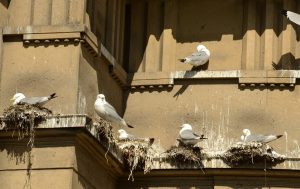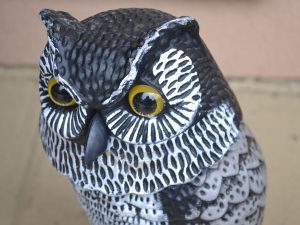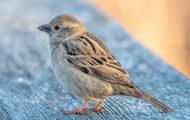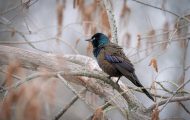Have you noticed some feathered visitors nesting around your home? Do you want to know how to keep birds from nesting on ledge? It’s not uncommon; in fact, many homes attract these guests, and it can become quite a nuisance. Bird droppings can discolor walls, patios, and other areas of the home. Plus, nests can create places for pests to hide, and they can block gutters or impede airflow through vents.
So how do you stop them from making this space their home? Keeping birds away involves creating physical and psychological barriers that make the area less attractive to them.
Questions come quickly: What kinds of barriers work best? Are there any natural deterrents? Will my efforts hurt the birds? Don’t worry! There are proven ways to protect your property without harm to avian visitors.
Reasons Why You Might Want To Keep Birds Away
 Before we discuss how to keep birds from nesting on ledges, let’s look at some of the reasons why you might want to do so:
Before we discuss how to keep birds from nesting on ledges, let’s look at some of the reasons why you might want to do so:
Bird Phobias
If you suffer from bird phobias, consider keeping birds away from your property. Many potential stressors come along with birds, especially if they are in your area, from being pestered by a hovering flock of birds to a fear of being attacked when trying to shoo them away.
Even seeing or hearing unfamiliar birds can be overwhelming for someone suffering from bird phobias. Not to mention, birds are known for carrying and spreading illnesses like salmonella and listeria. Any of these reasons is enough to convince you that keeping the feathered creatures away from your home and yard may be better.
Damage to Property
Birds can be quite destructive when they start nesting on your property. They may cause damage to the exterior of your home with their droppings and nests, as well as block vents or gutters, which can lead to more serious problems. Pests like rats, fleas, and mites may also find shelter in the nests, making keeping them away from your home even more important.
Invasive Species
Over the years, certain bird species have overrun spaces where they are not native and caused significant damage to both ecosystems and humans. There’s a good reason why you might want to keep birds away from your property: invasive species can disrupt the natural environment by competing with native birds for resources such as food, water, and nesting spots. They can also spread diseases and parasitism or interfere with local agricultural practices. Plus, once an invasive species has taken root in a region, it’s incredibly hard to get rid of them unless drastic measures are adopted.
Messy Nests
It’s no surprise why so many people don’t want to deal with birds harassing them on their property. Their nests can cause damage to buildings, patios, and other structures as they build their home in the surrounding area.
Moreover, birds can produce quite sizable amounts of droppings that accumulate quickly if left unchecked. Dry and wet waste both accumulate quickly, leading to a very unpleasant smell that is practically impossible to get rid of without proper cleaning and sanitizing techniques.
The results can be messy, unsightly, and absolutely repulsive if left alone for a prolonged period – potentially leading to problems like disease or infestations.
Protective Parents
Birds are fiercely protective of their young and won’t hesitate to attack a perceived threat if they feel their nest is in danger. This can be incredibly dangerous for anyone entering the area, as birds will defend their nests with powerful beaks, talons, and wings. For these reasons, keeping birds away from your property is best to avoid any unwanted confrontations or potential injury.
Unsafe Nests
In some cases, birds may choose to build their nests in areas that are potentially dangerous or unstable. Tall buildings, power, and other hazardous places might seem ideal to birds but can result in significant damage if they’re disturbed by someone or something. This’s important to take proper steps to keep birds away from your property – so they don’t inadvertently put themselves or others at risk of harm.
How To Keep Birds From Nesting On Ledge

Now that you’ve seen some of the reasons why you may want to keep birds away from your property let’s look at how to do it. Here are a few approaches for deterring birds from nesting on your ledge:
Slope Ledges
One effective method of keeping birds from nesting on ledges is by providing slope ledges that make it difficult for them to build their nests. Slope ledges are designed to be at an angle that makes it impossible for the birds to find a comfortable spot to build a nest or sit on the ledge. Here’s how to create slope ledges to keep birds at bay:
- Measure the width of the ledge to determine how much slope is needed.
- Purchase PVC pipe or wood planks that are long enough to span the width of the ledge.
- Use a saw to cut the PVC pipe or wood planks to the appropriate length needed for the slope.
- Attach the PVC pipe or wood planks to the ledge using brackets or screws, ensuring they are securely fastened to the surface of the ledge.
- Make sure there are no gaps that birds can still squeeze through.
Getting the proper slope angle may take some trial and error, but once you do, you can enjoy your ledges without any unwanted bird occupants.
Use Bird Repellents
Before you start using bird repellent, identify the type of bird you’re dealing with. Some bird species are protected by law, and harming them is illegal. Once you know the bird species isn’t protected, you can start using bird repellent.
There are different types of bird repellent available in the market, such as sticky repellent gel, plastic bird spikes, and ultrasonic repellent. The most common types are sticky gel and bird spikes.
A sticky repellent gel is a non-toxic, bird repellent that is used to keep the birds away. The gel creates a sticky surface, making it difficult for the birds to land on the ledge. It’s easy to apply and is long-lasting.
Plastic bird spikes are another effective bird-repellent method. These spikes are made of plastic and can be easily installed on your ledges. The spikes make it difficult for the birds to land on the ledge.
Ultrasonic repellent is a high-pitched sound that humans can’t hear, but it’s unpleasant for birds. The sound is emitted by a device that can be installed on the ledge. The sound waves will keep the birds away.
Keep in mind that bird repellent doesn’t harm birds; it repels them. The repellent can be humanely removed if the birds do manage to land on the ledge.
Install Shiny Objects
Birds are naturally drawn to shiny and reflective objects as they associate them with water bodies like ponds, lakes, and rivers. Installing shiny objects around your ledges will create an illusion of water, discouraging birds from nesting on them.
So, what kind of shiny objects can you install? Anything that reflects light and creates flashes of light will do the trick. You can use mirrors, aluminum foil, old CDs, or even hang reflective wind chimes. The idea is to create a reflective surface that constantly moves and reflects the light.
It’s important to note that installing shiny objects will only eliminate the bird problem after a period of time. You need to be consistent in your effort and install several shiny objects around the ledge. You can also try moving the objects around to create a sense of movement and to keep the birds guessing.
Remove Bird-Friendly Features
What are bird-friendly features? These are factors that birds find attractive and welcoming, such as food sources, water sources, and shelter.
Food sources include bird feeders, baths, and outdoor pet food dishes. If you have any of these on or near your ledges, you are inviting birds to visit and potentially nest there. Removing these features is a surefire way to discourage birds from taking up residence on your ledges.
Water sources, such as pools, fountains, or even small puddles, can also be attractive to birds. If you have any of these near your ledges, it’s best to either move them or cover them up to discourage birds from using them.
Pruning
Pruning is the process of trimming back plants, shrubs, and trees in your yard. It helps to keep everything tidy and promotes healthy growth, but it also has the added benefit of deterring birds from nesting on your property.
Birds typically like to nest in areas that provide cover and protection, such as dense bushes or overgrown trees. You create a less desirable bird nesting environment by pruning back these areas. They will be less likely to linger around your property if there are no ideal nesting areas available.
When pruning, pay special attention to areas near ledges or windows. These are prime bird nesting spots, and you want to make them as uninviting as possible. Trim back any overgrown branches within a few feet of the ledge. This will make it more difficult for birds to access and nest on your property.
It’s also important to note that pruning should be done during the appropriate time of year. Generally, it’s best to prune in winter when trees and shrubs are dormant. This will promote healthy growth in the spring and minimize the risk of harming nesting birds.
In addition, it’s important to ensure you are not breaking any laws or regulations when pruning. Some bird species are protected under federal law, and it’s important to check with your local government before taking any action.
Restricting Entrance Holes
First off, it’s important to understand that restricting entrance holes does not mean blocking birds from flying around your place altogether. It simply means you’re preventing them from building nests on your ledges or walls.
By blocking entrance holes, birds will not be able to access the interior of the building, where they are likely to cause damage, make a mess, or create potential health hazards.
One simple way to restrict entrance holes is by attaching netting to your walls or ledges. Bird netting is a mesh material made from polyethylene which is flexible, durable, and long-lasting. Once the netting is in place, birds will not be able to fly through it, but it still leaves enough space for their feathers to pass through without getting trapped. It’s an effective yet humane way to keep birds from nesting on ledges.
Moreover, you can also use scare tactics to stop birds from returning to your ledges. Motion-activated devices that play bird distress calls or flashing lights can help deter birds from nesting on your property. These methods are humane and safe for the animals.
Put A Decoys
Decoys such as fake owls have been widely used to deter birds from nesting on ledges. They mimic the appearance and movement of real birds, making it less likely for other birds to nest in the same area.
Some decoys come with motion sensors that activate when a bird is detected, making the whole setup even more realistic. This will send a clear message to other birds that this spot is already taken and that they need to find another nesting spot.
Another benefit of using decoys is that they can double as a decorative element. For instance, if you have a roof garden, the decoy can blend in nicely with the outdoor décor, adding a touch of style and practicality.
Call A Professional
These companies specialize in bird control and are equipped with bird deterrents that will prevent birds from making a home in your building. These deterrents come in many forms, including bird netting, spikes, and even electronic devices that emit bird distress calls.
One of the biggest benefits of working with a professional pest control company is their knowledge and expertise. They can assess your situation and determine the most effective bird control solution for your specific needs. They can also install the deterrents correctly to ensure maximum effectiveness.
Another great benefit of working with a professional pest control company is their ability to maintain and inspect the deterrents regularly. This is important because even the best deterrents may require upkeep to continue working effectively.
Frequently Asked Questions
Q: What species of birds are usually found nesting on ledges?
Many species of birds are known to nest on ledges, including European starlings and house sparrows. These birds often use the shallow ledges around buildings and other structures as nesting sites. Starlings tend to prefer elevated ledges sheltered from the wind and rain, while sparrows will make nests under overhangs or even in the open when no rain is expected. It’s not unusual for these species to nest closer to humans than any other wild animal, with colonies forming along city streets and parks like small neighborhoods!
Q: Can I use a spray to keep birds from nesting in the pavilion?
It sure is possible to use a spray to keep birds from nesting in a pavilion. Sprays made with ingredients like red pepper, black pepper, and garlic oils can effectively keep birds away from various areas of your lawn, such as the pavilion. You can even make your own spray solution! All you need to do is mix the desired ingredients with water and use an adjustable nozzle garden hose attachment to aerosolize the mixture and target specific areas around the pavilion. Doing this weekly or twice weekly, depending on where you live, should help keep pesky birds away long-term.
Q: How to get rid of a bird’s nest on my balcony?
It can be tricky if you have a bird’s nest built on your balcony. First, you must ensure that the eggs are not yet hatched. If this is the case, wait until the baby birds have left before attempting to get rid of the nest. If no eggs are present, begin by removing the material used to build the nest itself. This may include twigs, straws, and other objects brought together. Once you’ve done that, you can use a broom or brush to clean out any remaining materials in the area. Be mindful when cleaning, as you don’t want to cause any harm or distress to any lingering birds.
Q: Does fake bird nesting help deter real birds from making a home?
Whether or not fake bird nesting helps deter real birds from making a home is debatable and depends on several factors. Suppose a realistic, high-quality nest is used. In that case, it can be successful in initially fooling birds into thinking the area already has wildlife present and dissuading them from attempting to make a home there. Conversely, some animals tend to become attracted to these artificial nests. They take them as an invitation, prompting them to investigate the structure further. Ultimately, it would be best to experiment with fake bird nesting in your home. Evaluate whether it works aesthetically and observe how wildlife responds!
Q: Can I use a sound deterrent to keep birds away?
Yes, you can use a sound deterrent to help keep birds away from your property. Sound deterrents come in forms, including mechanical devices that emit high-pitched sounds or ultrasonic waves and bird decoys that appear lifelike and produce realistic calls. These devices can effectively keep birds away. However, they must be combined with other deterrents, such as netting and reflective materials.
Final Words
Keeping birds away from ledges and other areas of your home is an important and ongoing challenge. But with the right combination of deterrents, such as netting, fake nests, sound devices, and reflective materials, you can effectively keep birds away while allowing them access to natural places to nest safely. Remember that it will take time and dedication to keep unwanted birds away from your home in most cases, but the result is worth the effort!




